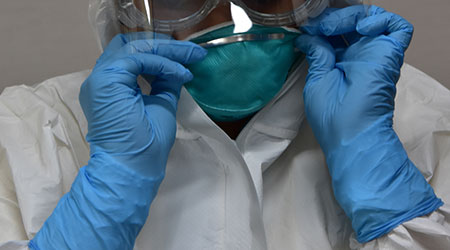The outbreak of COVID-19 has been a wake-up call for public health and healthcare officials alike. This respiratory disease, caused by a coronavirus, SARS-CoV-2, is a reminder of the importance of infection prevention efforts and the need for continued vigilance.
While the overall risk for contracting COVID-19 in the United States is low, it’s important to not discount that this current influenza season is quite severe, and that flu is a much more likely threat. Attention has mostly been focused on this new outbreak, but millions of Americans have already been battling respiratory illnesses and influenza for weeks. Based off preliminary data, the U.S. Centers for Disease Control and Prevention (CDC) is estimating that for the 2019/2020 flu season (October 1, 2019- February 15, 2020), there have been between 29-41 million flu illnesses and between 16,000 and 41,000 flu-related deaths.
The spread of both COVID-19 and flu-related illnesses remind us of the critical role of infection prevention. Everything from vaccines to personal protective equipment (PPE) to hand hygiene and environmental disinfection, play a vital role in helping prevent the spread of infections. It’s easy to view flu and even COVID-19 prevention in the context of only PPE, but we can’t discount the critical role of environmental bioburden.
When people with respiratory infections cough or sneeze, the infectious droplets land on surfaces and objects, which contaminates them. These respiratory viruses, especially coronaviruses, are not environmentally hardy, meaning they are easy to kill via standard disinfection practices with EPA-registered disinfectants for enveloped viruses.
However, the challenge is if too much of the attention is on PPE, some may neglect the environmental component to disease prevention. When infected people fail to wash their hands or cover their cough, the environmental disinfection component to infection prevention is the stopgap, making it imperative to preventing the spread of infection.
In fact, the CDC guidance for SARS-CoV-2 notes that “products with EPA-approved emerging viral pathogens claims are recommended for use against SARS-CoV-2. If there are no available EPA-registered products that have an approved emerging viral pathogen claim for SARS-CoV-2, products with label claims against human coronaviruses should be used according to label instructions.”
There are several products with EPA-approved emerging viral pathogen claims that are available for surface disinfection against SARS-CoV-2, including Clorox Healthcare® Bleach Germicidal Wipes.
What we can take away from these recommendations and the concerns regarding respiratory illnesses, including both COVID-19 and the flu, is that disinfection remains a critical component to infection prevention and we already have the tools to combat such respiratory viruses.
Hospitals and healthcare facilities are working to ensure they are ready for possible patients with respiratory illnesses and part of these measures include ensuring the right products are available, training staff to use products currently, and monitoring environmental disinfection compliance.
From cleaning high-touch surfaces and workstations to using dedicated medical equipment, environmental infection prevention is a foundational piece to disease control. Shortages of PPE is a concern during this respiratory virus season and while hospital supply chains work to acquire adequate supplies, this is the time to hone in on environmental measures.
Just like our practices during flu season, we can ensure routine cleaning is being done in high-risk areas like emergency department waiting areas. Rounding and asking staff (both clinical and environmental services) their processes is helpful to engage that reminder of environmental cleanliness during respiratory virus season.
CDC guidance pushes us to also execute routine environmental cleaning and disinfection for patients in isolation, so now is the time we ensure those practices are as efficient and effective as possible. Make sure privacy curtains are laundered appropriately to avoid contamination – linens play a bit role in environmental infection control!
Moreover, beyond educating staff on the proper screening and isolation for those with respiratory symptoms, we can also remind them about the power of a single disinfecting wipe and that cleaning is not limited to what is done by environmental services staff.
I always encourage frontline staff to grab a disinfecting wipe and wipe down their work areas as a routine practice to end their shift. Desks, keyboards, counters and phones are all high-touch items that can act as transmission mechanisms for respiratory viruses. Waiting rooms can easily be neglected, so it’s important to make sure there cleaning of high-touch surfaces. More so, don’t forget routinely remove those objects that can’t be cleaned, like magazines.
Environmental disinfection is a key part of preventing both influenza and even COVID-19. We all have a role in prevention and with the right products and training, it is possible for everyone to take responsibility and play their part. Practice makes perfect and given the severe flu season and potential spread of SARS-Cov-2, now is the time for facilities to focus on environmental disinfection efforts to ensure preparedness and effectiveness against such respiratory viruses.
Dr. Saskia v. Popescu is a paid consultant for Clorox Healthcare.

 Grounding Healthcare Spaces in Hospitality Principles
Grounding Healthcare Spaces in Hospitality Principles UC Davis Health Selects Rudolph and Sletten for Central Utility Plant Expansion
UC Davis Health Selects Rudolph and Sletten for Central Utility Plant Expansion Cape Cod Healthcare Opens Upper 2 Floors of Edwin Barbey Patient Care Pavilion
Cape Cod Healthcare Opens Upper 2 Floors of Edwin Barbey Patient Care Pavilion Building Sustainable Healthcare for an Aging Population
Building Sustainable Healthcare for an Aging Population Froedtert ThedaCare Announces Opening of ThedaCare Medical Center-Oshkosh
Froedtert ThedaCare Announces Opening of ThedaCare Medical Center-Oshkosh